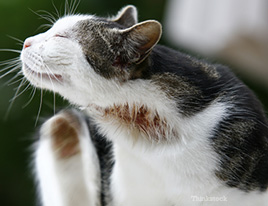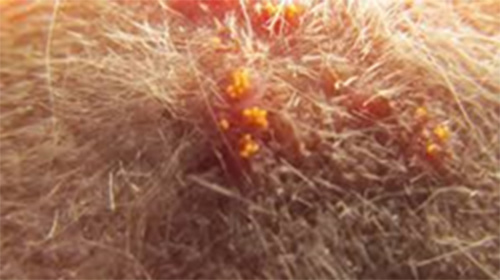Harvest Mites: June to August Pets with Itchy, scabby skin!!
Mites, aside from ticks, are usually only noticed when skin problems and mange become evident. Mange or harvest mites are usually characterized by itchy skin, hair loss and general skin irritation, 50% of pets visiting the salon at the moment are showing signs of harvest mites which are bumpy scaly skin, small scabs & sores, hair loss & itchy skin if your pet shows any of these symptoms then we are 90% sure it is harvest/grass mites that burrow under your pets skin & cause major irritation, we see these signs year after year in the months of June, July & August, they look like little spots of orange pollen & tend to be in between toes, around the nose , in armpits etc…
Conventional methods of eradicating mites will often depend on the type of mite living on your pet. However, most conventional treatments will involve some type chemical based lotion, dip or shampoo. Many of these products contain harsh chemicals such as amitraz, ivermectin, and selamectin which often come with warnings but we at Posh Pets Spain are used to handling such chemicals & ensure the total safety for your pet & ourselves.
Apple Cider Vinegar, Neem and Lemongrass also act as natural insecticides and their natural skin healing properties help to soothe irritated skin and promote healing after a nasty mite infestation. Lastly, the herbal ingredient Niaoli works as an antiseptic, and helps to cleanse and heal the skin. It also works as an excellent tissue stimulant and can be given to pets to help the skin heal and re-build after the treatment mange/harvest mite infestation
The Season for Harvest mites
• Harvest mites or ‘Trombiculodis’ are small orange mites, these look like simple orange pollen powder on your pet that is more common around late summer particularly in the region of Southern Spain.
• It is easily spotted as tiny orange dots/ powder on your pets skin
• It can cause intensely itchy reactions on your pet, and is often found in small crevices, such as between the toes or in the folds of the ears.

What is a harvest mite?
The harvest mite (Trombicula autumnalis) is a tiny mite the larval stage of which causes considerable discomfort to cats and dogs during the late summer and autumn. The mite is particularly abundant in chalky areas and gardens where soft fruit is grown.
The larval stage when it has six legs is the only stage which attacks warm blooded animals. All other stages live in the environment and are not parasitic. The larvae congregate on small clods of earth or on vegetation. They are active during the day and particularly in dry sunny weather, ideal conditions are in Southern Spain. When a warm blooded animal comes into contact with the larvae they swarm onto it and attach onto skin particularly in sparsely haired thin skinned areas. The larvae feed for 2 to 3 days and they drop off onto the ground to complete the life cycle. The larval mite is orange and only just visible to the naked eye. The larva burrows into the skin and causes much pain and discomfort.
We treat many pets on a daily basis at present, including all our own dogs here at our home.
Effects that harvest mites have on cats & dogs.
The six legged larval mite attaches to the skin of cats and dogs to feed. It fixes onto the skin by small hooked fangs and then injects fluid into the skin which liquefies cells. The resulting liquefied food is sucked back by the mite. The fluid injected by the mite is very irritant. An irritation in a pet causes the pet to scratch, bite and lick which may result in extensive self-inflicted injury. The resulting skin lesions vary from crusted spots to areas of hair loss to raw moist bleeding areas
Related Articles
The Poisonous toad in your garden, here in Andalucia
If you notice your dog foaming at the mouth after messing with a toad, immediately rinse it out with water. If the dog eats the toad, you should probably get it to a vet or animal hospital right away. The giant toad can grow up to eight inches long and is very heavy....






Recent Comments